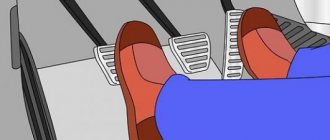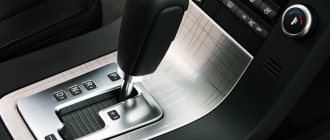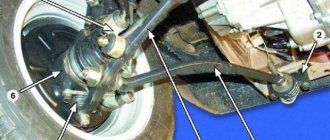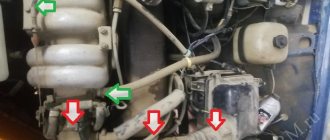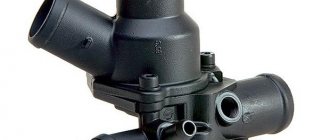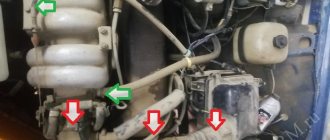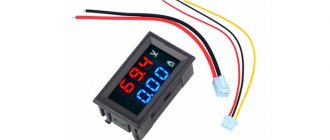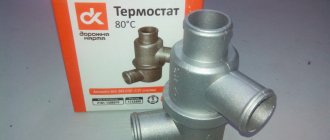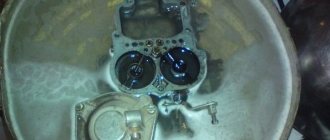Many young people are interested in the question of how to skid on the spot? Such actions are popular primarily among young, novice street racers who have bought their first car. At the same time, you should know that the consequences of this will not keep you waiting. This applies to both manual and automatic gearboxes.
How to slip in place in a car with a manual transmission? If we consider the action from a professional point of view, then this is necessary in order to warm up the car’s tires before a quick start. A sport that requires quick heating of the tires is called “drag racing.” In this case, the specifics of the actions depend on the type of gearbox. In this case, you must perform the following steps:
- Choose a safe area for this, preferably covered with asphalt;
- Warm up the engine to operating temperature;
- Raise the parking brake lever as much as possible;
- You need to press the gas and brake pedals at the same time. At the same time, the last pedal is not pressed all the way;
- The engine will begin to gain speed, and the drive wheels will spin in an interval depending on the speed.
On an automatic gearbox the situation is somewhat more complicated. This will require a slippery surface: snow, ice, sand. The procedure is to perform similar manipulations. The only difference is that it is not advisable to make long jerks. The engine of the car should cool down a little in seconds. It is not recommended to stop the engine at this moment; it should run at idle speed. In addition, the car must be warmed up to operating temperature. If this is not done, oil will not be supplied to the automatic transmission, and the result will be its subsequent replacement.
Healthy!
Let's consider a situation where a car with a gun is stuck in the snow. To get out of there, you need to switch the gearbox to “R” mode, but before doing this, depress the brake pedal. After this, you must wait at least 3 minutes and smoothly release the brake pedal, increasing the speed. A sharp increase in this number can lead to damage to the gearbox clutches. Switching from one speed to another is strictly prohibited.
How to do slipping on the spot?
Some people consider spinning to be pranks that young people do for fun. But it is not always the case. In drag racing, skidding heats up the tires. The slipping technique will vary depending on the type of transmission.
How to slip on a manual transmission?
In order to start slipping in a car with a manual transmission, press the brake and gas pedals at the same time. At the same time, do not press the brake pedal all the way. The engine picks up speed, and when to release the clutch is up to whoever is driving.
How to slip on an automatic transmission?
Without harm to the car, you can slip with an automatic transmission using neutral. Naturally, each gearbox has its own characteristics, but before you start drifting in place, it’s a good idea to read the instruction manual.
Recommendations
There are some rules regarding proper slippage.
- You can’t skid in place for a long time, because the gearbox needs rest. Skid periodically, so both the driver and the car will rest. There is no need to turn off the engine while resting.
- You cannot skid on a cold car. Hasty actions will lead to wear of significant parts of the automatic transmission, since slipping will begin without any lubrication of the mechanism.
- Before attempting to drive out of a snowdrift, turn on R mode, first pressing the brake pedal. We stand in this position for at least a minute. During this time, the required amount of lubricant will be pumped through the torque converter.
- When skidding, you should avoid too sharp traction with the road. The higher the load, the faster the clutches on the automatic transmission will fail.
Which cars are not suitable for towing?
- Low efficiency of the cooling system can provoke a critical condition due to increased heat generation in the torque converter. The radiator will become clogged with wear products. Such difficulties are typical for cars with high mileage. Let's include here all American cars produced back in the 80s and 90s.
- Older Japanese and European cars have air transmission cooling systems. This means that the automatic transmission is cooled while driving, and therefore slipping on them can only be to the detriment of the “health” of the car. True, there are practically no such cars in Russia anymore, since they are small cars that rarely hit our market.
If you follow these simple rules, you can skid without causing any harm to your iron horse. You don’t want to pay for expensive repairs or buy new tires because of a simple mistake? Always be careful when driving.
How to slip?
Some people consider spinning to be pranks that young people do for fun. But it is not always the case. In drag racing, skidding heats up the tires. The slipping technique will vary depending on the type of transmission.
How to slip on mechanics
In order to start slipping in a car with a manual transmission, press the brake and gas pedals at the same time. At the same time, do not press the brake pedal all the way. The engine picks up speed, and when to release the clutch is up to whoever is driving.
How to slip on automatic
Without harm to the car, you can slip with an automatic transmission using neutral. Naturally, each gearbox has its own characteristics, but before you start drifting in place, it’s a good idea to read the instruction manual.
Recommendations
There are some rules regarding proper slippage.
- You can’t skid in place for a long time, because the gearbox needs rest. Skid periodically, so both the driver and the car will rest. There is no need to turn off the engine while resting.
- You cannot skid on a cold car. Hasty actions will lead to wear of significant parts of the automatic transmission, since slipping will begin without any lubrication of the mechanism.
- Before attempting to drive out of a snowdrift, turn on R mode, first pressing the brake pedal. We stand in this position for at least a minute. During this time, the required amount of lubricant will be pumped through the torque converter.
- When skidding, you should avoid too sharp traction with the road. The higher the load, the faster the clutches on the automatic transmission will fail.
Cooling box
Heat in automatic transmissions is generated by both the friction discs and the torque converter; under heavy loads, overheating is extremely high; for this purpose, cars with automatic transmissions are equipped with a powerful cooling system. The radiator is built into the engine cooling radiator element, or is cooled using a separate air flow.
When slipping for a long time, the temperature of the lubricant of the automatic transmission rises sharply, until it boils. This leads to the destruction of the friction discs, which are forced to work “hard”. And in the worst case, it can lead to transmission failure.
Conclusion 1. It is permissible to slip with an automatic transmission, but not for long and intermittently.
What to do if you are stuck on front-wheel drive?
Let's consider several possible situations:
- If the left wheels are on the asphalt (or any other hard surface), and the right wheels are on the side of the road (or in a snow and mud “mess”), then you do not need to reduce or increase the speed and under no circumstances should you turn off the gear. We smoothly bring the car onto a hard surface without changing the pressure on the gas pedal.
- If, while the car is moving, all four wheels are on the side of the road (snowy road, snow and mud “porridge”), then you need to turn on a lower speed and increase the pressure on the accelerator pedal (this way, with the front wheels driving, it is easier for you to stabilize the movement). We smoothly drive the car onto a hard surface.
- If you are stopped in a snowy area and cannot start moving due to wheel slip. Remember: when you press the gas pedal, a front-wheel drive car “lifts” the front end, thereby redistributing the weight of the entire car to the rear, which is worth taking advantage of in this situation. We engage first gear, and by briefly pressing the gas pedal we “rock” the car back and forth (successive presses: gas pedal - clutch pedal - gas pedal - clutch pedal and so on), without changing the position of the steering column. When the wheels begin to cling to the surface, we gradually increase the speed.
- If after the previous steps you were unable to leave, then you need to manually clean the coating near the front wheels (it is recommended to have a small shovel with a short handle in the trunk in the winter). It is necessary to clean a distance of about 50 centimeters from each wheel. If you do less, there is a high probability that you will pass the cleared area and skid again, since the inertia of movement will be minimal.
- What to do if you skid on an icy section of the road while climbing? In this case, you need, without turning off the gear, slow down, switch to a lower gear and gradually increase the speed (to approximately 1400-1500 rpm). If you sharply increase the speed, then slippage is inevitable.
Not enough power under the hood
IV. If the car does not have enough power for such experiments, in this case, experts have some tricks in stock that help one hundred percent prevent the wheels of the car from slipping.
1. Lighten your car, especially for rear-wheel drive cars. There should be nothing unnecessary in the trunk, not even a spare tire. Before arriving at the site, take care of this in advance. The car's axle will be slightly unloaded, and it will be easier for the wheels to slip.
2. Burnout - slipping on a chip. Rolling back at low speed with the clutch depressed, you do almost everything the same as the previous times. Release the clutch, then press the gas, but do not press the brake. As a result of the influence of multidirectional forces, one of the forces will be directed downward, and the engine force will be directed in the opposite direction, that is, it will pull upward; in this case, the car will remain in place without the brakes applied.
3. Try this on a wet surface. The grip on the asphalt will be much weaker than it would be in dry weather, and this will definitely increase your chances of success.
V. And in conclusion. To reduce stress on the braking system itself, use the Brake line locking system, i.e., a lock. After installing it on the car and pressing the button, it will automatically turn off the rear brakes. This will simplify your task and keep the car in its original technical condition.
And as a snack for all readers: Fail and Win compilations of burnout.
Motorbike
On a motorcycle it is enough to install side protection, because... During training, you can turn the bike on its side. A machine with easy clutch release will come in handy, because... You will have to constantly depress the clutch. With a standard machine, your fingers will get tired much faster. The pressure in the rear wheel does not matter much. The standard one is quite suitable for training. It is advisable to adjust the brake lever so that it is as close as possible to the steering wheel. This will reduce the stress on your fingers and allow you to feel the brakes better.
Burnout standing still
This is the easiest way! You can start with the front wheel resting against the wall.
- Do not release the gas while releasing the clutch, i.e. keep stable. You instinctively want to turn off the gas, but you can’t do this.
- Press as hard as possible on the fork when releasing the clutch, i.e. stand up on your hands.
- Completely block the front wheel. Do not slow down, but press the front brake firmly and do not release. At first, it will not be easy to hold the brake depressed and twist the gas.
Burnout in a straight line
The main difference from burnout on the spot is that burnout must be turned on while moving. In fact, it's easier, because... You can additionally load the fork by braking the front wheel. Therefore, while driving, the rear wheel can be torn off at low speeds (4-6 thousand).
- Shift your body weight forward as much as possible, standing on your toes if necessary. At first it will seem like you'll fly over the steering wheel. If you don't stop abruptly, you won't fly over)
- Always cool the front brake. After a few tries the front brakes become very hard.
- Don't be afraid to ease up on the front brake to go faster. Even if you completely release the front brake, nothing bad will happen: the motorcycle will begin to quickly accelerate in a straight line and the axle box will gradually become engaged.
Front wheel drive cars
III. On front-wheel drive, burnout is somewhat easier. To do this, you need to hold the parking brake, then raise the engine speed and just as smoothly and quickly release the clutch pedal. As a result of such a rapid (almost instantaneous) increase in speed of rotation of the front wheels, the car will not move forward and will not stall; remaining in one place, it will begin to release the coveted and long-awaited puffs of smoke from under its tires.
On front-wheel drive, it is much easier to do burnout-slip. But there is one important nuance: the car’s handbrake must be in good working order, it must be able to hold the car in place.
Burnout eight
Burnout figure eight consists of circles, so you need to learn to circle in both directions. It makes sense to learn circles if you consistently achieve controlled movement in a straight line.
- Before entering a circle, it is better to reduce the speed with the front brake. When the front wheel rotates slowly, the skid occurs with less inclination, making it easier to get out of the circle, because You won’t have to dampen the tilt with strong pressure on the steering wheel.
- It is advisable to run laps at high speeds. This is necessary so that there is a reserve of revolutions when they need to be reduced. If the rpm drops to idle, the motorcycle will stall.
- Concentrate more on the handlebars than on the footpegs. You need to tilt the motorcycle by transferring your body weight to your hand, and not by pressing your foot on the footrest.
- Before leaving the circle, you need to loosen the front brake so that the motorcycle levels out and goes in a straight line. It is advisable to reduce the speed so that the output is softer.
If you have any comments or additions, write to us and we will update the article!
We made a compilation of the most interesting moments that we managed to capture. Everyone was included in the video: from scooter riders to world champion Marcin Glowatski!
The experience of pro-riders and amateurs has shown that often screwed-in construction screws with a flat head and protruding 1-1.5 cm work well for stunt bikes. The reliability of fixing the studs depends on the type of cord and tread thickness. It is not advisable to use worn rubber with this studding method.
For a standard set of tires (120 front and 180 rear) it took us about 10,000 screws. Screwing in self-tapping screws is tedious, but you can master it in a few days at a leisurely pace. The rubber gained a lot of weight and became stiffer.
The wheel rims have a recess for the valve on the inside. To prevent the camera nipple from rubbing against the edges, it is advisable to place a gasket or rubber washer, which can be made from an old valve.
Burnout technique, what you need to know about wheel slip on the spot: Video
WARNING! DO NOT USE THE BURNOUT TECHNIQUE IN PLACES OF LARGE CLOCKS OF PEOPLE AND ON PUBLIC ROADS!
Burnout, an effective technique for warming up tires or a spectacular way to show off in front of others. In any case, the ability to do a burnout will help you get a better feel for a car with a manual transmission and ruin a couple of tires.
An expert in auto mechanics and physics, Jason Fanske from the YouTube channel “Engineering Explained” again held a cultural education for his viewers. In a new form, Jason explained in detail the basics of the burnout technique, citing as an example his rear-wheel drive Honda S2000 with a manual transmission.
First, the video explains in what cases this technique is used and why it is needed.
-The coefficient of adhesion of cold tires to the road surface may be low and if necessary, it needs to be increased. If you warm up your tires, their temperature will increase, they will become softer and their grip will increase. Where is it used? Mainly in drag racing.
It is further mentioned (1.26 min video) that the process on an automatic transmission is quite simple. Press the brake, then press the gas. As soon as the wheels to which the drive is driven begin to rotate, weakening and increasing the pressure on the brake pedal, it is necessary to regulate the rotation of the wheels and prevent the car from moving.
Inscription at the top: Make sure the traction control is turned off!
On cars with a manual transmission, the narrator continues, everything is somewhat more complicated (1.47 min video). To do this you need:
- Depress the clutch
- Engage first gear
- Lightly press the accelerator pedal, release the clutch and immediately press the brake pedal with your left foot
As soon as you manage not to stall at this moment or to avoid slipping forward (in particular, due to the likelihood of uncontrolled acceleration of the car, burnout is so dangerous both for those around you and for the driver himself), proceed to working with the brake and gas pedals, also , as with an automatic transmission.
In addition to the equipment itself, the video mentions that it is extremely important to know at what speed the wheels of your car begin to slip on the asphalt. In the S2000, the author says, slippage begins at approximately 5,000 rpm. If you overclock the engine, there is a danger of burning the clutch instead of the tires; if the engine speed is not enough, the car will not have enough torque to overcome the grip of the tires on the road surface.
And finally, at 2.48 minutes of the video it shows how hot the tires are during a burnout. Note that the first few attempts were unsuccessful, but even so, the tire temperature increased by 4 degrees, from 15 to 19 degrees Celsius. Moreover, the inner side of the tire heated up the most, up to 20 degrees, due to the reverse camber of the wheels.
At the end of the action, the tires were heated to 160 degrees Celsius!
This is such an interesting educational program in the world of sports and automotive extremes.
Information publication: Traffic police news, accidents, traffic fines, traffic police, Online traffic rules exam. Technical inspection
Repair cost
The cost of repairs for a slipping transmission depends on the specific breakdown. In some cases, this problem can be eliminated by replacing the transmission oil and filter elements. In this case, the cost of work with spare parts will not exceed 5,000-10,000 rubles. At the same time, if there are problems with the valve body, clutches or control unit, the cost of repairs can amount to several tens of thousands of rubles. Remember that the exact cause of a breakdown can only be determined by carrying out the most detailed diagnostics. It is after such a diagnosis that an experienced specialist will tell you the amount of repairs and only after that will begin to fix the breakdown.
When planning repair work on the gearbox, it is necessary to remember that the automatic transmission is a complex structural element, the quality of which can only be serviced and repaired by experienced specialists. That is why we do not recommend that you skimp on the quality of repairs and trust garage specialists to fix problems. Only by contacting specialized service centers, you will be able to completely eliminate existing problems in the operation of gearboxes and receive a guarantee for the repairs performed.
